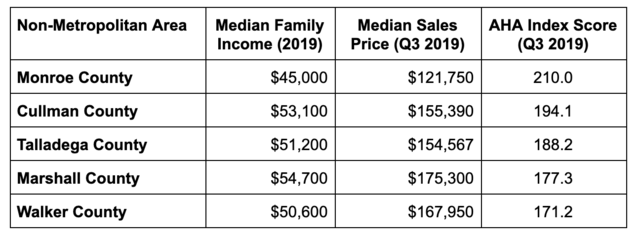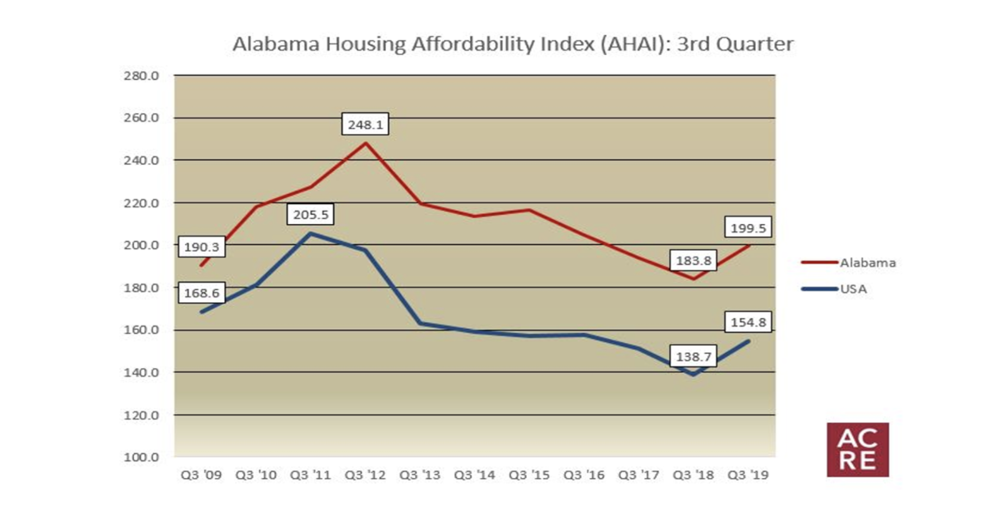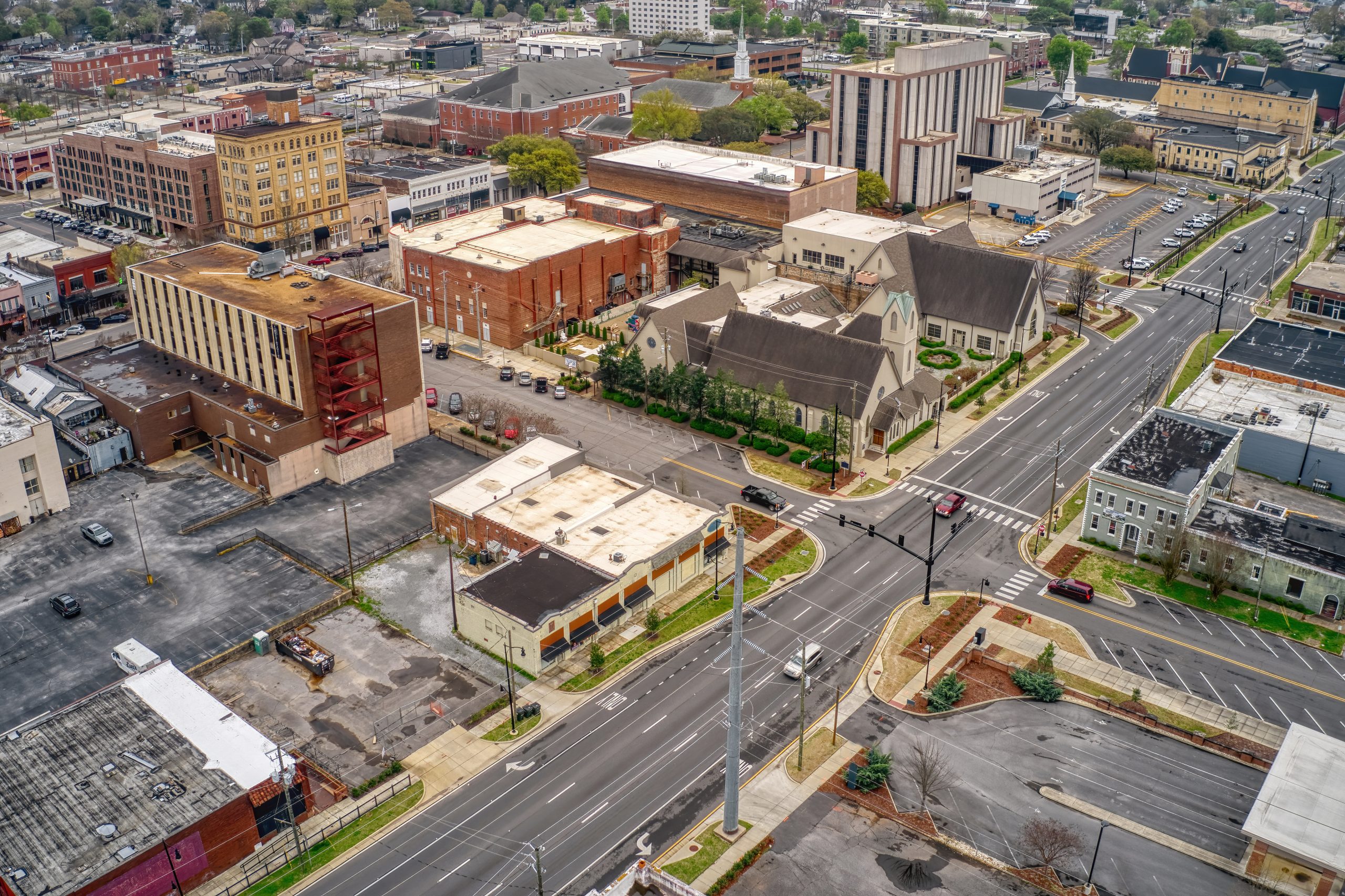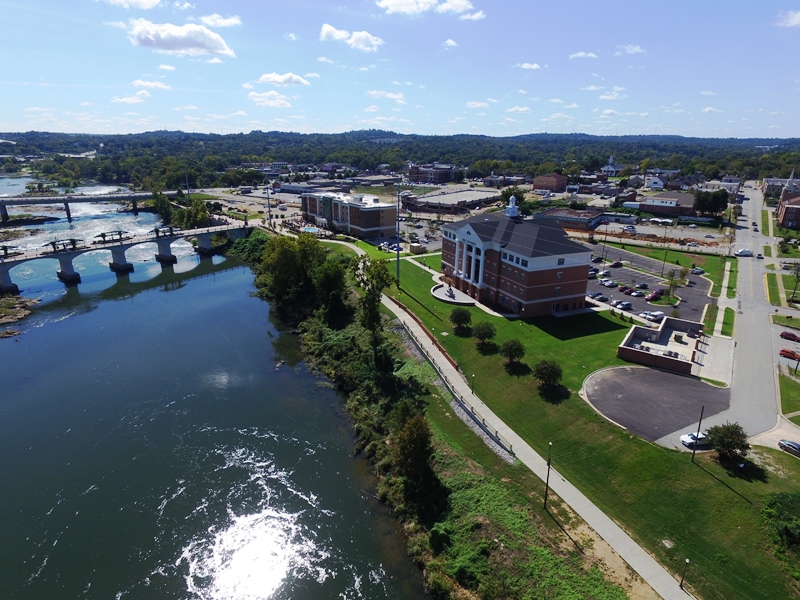Real estate markets throughout Alabama have had a strong year through the third quarter of 2019.The Alabama Statewide Housing Affordability Index (AHAI) decreased 0.75% this quarter to 199.5 when compared to Q2’s score of 201.0. This slight decrease was caused by the appreciation of home prices throughout the state, but was also offset by declining interest rates. The composite monthly interest rate fell from 4.00% to 3.67% quarter-over-quarter, while the median sales price of Alabama homes increased from $172,294 in the previous quarter to $180,686 in quarter 3. Rising home price appreciation and falling interest rates were also met with a 5.48% year-over-year increase in median family income (MFI) in Alabama.
The minor decrease in AHAI this quarter means that a family earning Alabama’s median family income of $63,500 has a little less than 2 times the required income to qualify for a loan to buy the statewide median-priced home, assuming an 80% loan-to-value ratio. The National Housing Affordability Index for the third quarter of 2019 was 154.8, 29% lower than Alabama’s third quarter score. A family earning the nation wide median family income of $75,500 has a little more than 1.5 times the necessary income to buy the nationwide median-priced home, which was $277,133. Even though the national median family income is 13% higher than that of Alabama, Alabama still continues to be more affordable than the nation as a whole due to the relatively low housing prices as well as consistent wage growth in recent years.
To read the Alabama Center for Real Estate’s entire Q3 2019 Alabama Housing Affordability Index, with a detailed explanation of the AHAI’s methodology, click here.
Alabama’s Most Affordable Metropolitan Areas
The table shows Alabama’s most affordable metropolitan areas. There are 12 of these areas in the state, according to the Center for Business and Economic Research (CBER) at the University of Alabama. Alabama’s metropolitan areas are Florence-Muscle Shoals, Anniston-Oxford, Decatur, Montgomery, Gadsden, Mobile, Huntsville, Tuscaloosa, Dothan, Birmingham-Hoover, Daphne-Fairhope-Foley and Auburn-Opelika.
The smallest metro area in terms of population is Gadsden, with 120,755 residents in the metro area in 2017. Gadsden’s population is slowly declining according to Census data, and CBER projects that the Gadsden metro-area population will drop by 3.7% with 100,612 projected residents in 2030.
The largest is Birmingham-Hoover, with 1,147,417 residents in the seven-county metro area. CBER projects a 7.3% increase in population to 1,210,100 residents by 2030.
The fastest-growing metro area in the state is Daphne-Fairhope-Foley. There were 208,563 residents in the metro area during 2016. CBER projects that the metro population will increase 43.6% from 2010 to reach 300,899 by 2040.
The most affordable metro areas in Alabama, ranked by ACRE’s Alabama Housing Affordability Index, are Florence-Muscle Shoals (251.7), Anniston-Oxford (234.0), Decatur (226.4), Montgomery (222.4) and Gadsden (221.3). One notable observation is that the two most populated metro areas in Alabama, Birmingham-Hoover and Huntsville did not make the top five most affordable metro areas. This can be attributed to a high median sales price, $221,000 in Birmingham and $224,131 in Huntsville, in the third quarter of 2019 which is not uncommon for the two largest metro areas in the state.
The least affordable metro areas are Auburn-Opelika (161.7) and Daphne-Fairhope-Foley (186.3). The quarter-over-quarter increase for these markets total 2.25% in Auburn-Opelika and 6.91% in Daphne-Fairhope-Foley. Both areas have median family incomes significantly above the state average, but are also home to median sales prices in the mid 200s range: $249,829 for Auburn-Opelika and $245,500 in Daphne-Fairhope-Foley. It should be noted, however, that the median price in Daphne-Fairhope-Foley includes condominium sales, many of which are of the ultra-luxury, beachfront type.

Alabama’s Most Affordable Non-Metropolitan Areas
The four most affordable non-metropolitan areas in Alabama are Monroe County (210.0), Cullman County (194.1), Talladega County (188.2), and Marshall County (177.3). Five out of six non-metro areas showed a decrease in affordability this quarter.
Notably, Cullman County was the only non-metropolitan area to see an increase in their third quarter AHAI score. This quarter’s score of 194.1 rose 8.9% when compared to the previous quarter’s score of 178.3.
At $54,700, Marshall County has the highest median family income of Alabama’s non-metro areas. This can be explained Marshall County’s proximity to the Huntsville metro area and overall job growth in north Alabama. Huntsville-area real estate, again, is somewhat expensive, so it is not surprising that many people buy houses in nearby areas, such as Marshall County, and commute to Huntsville for work.
The least affordable non-metropolitan area in Alabama is Tallapoosa County, with an AHAI score of 106.6. Quarter-to-quarter data tells us that Tallapoosa County is the only area in the state that is consistently below the national AHAI score. However, Tallapoosa County’s median sales price of $286,167 includes a significant number of expensive waterfront homes on Lake Martin.






